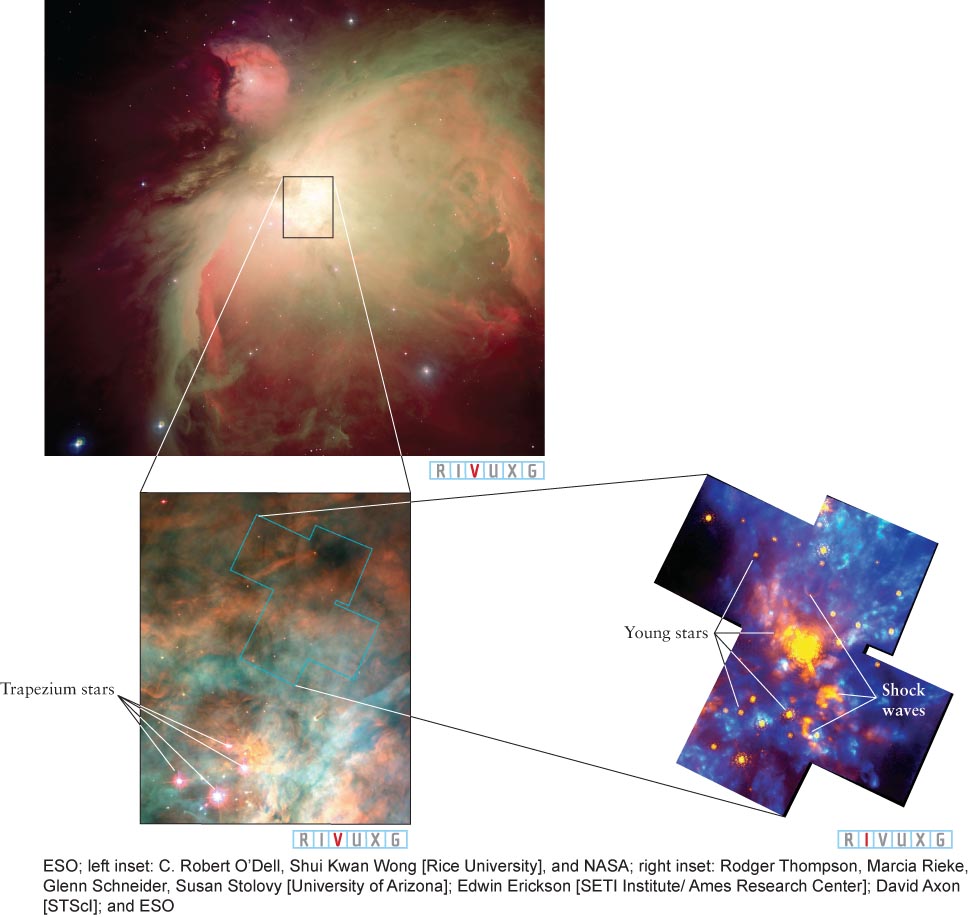
Figure 11- 15 The Orion Nebula The middle “star” in Orion’s sword is actually the Orion Nebula, part of a huge system of interstellar gas and dust in which new stars are now forming. The Orion Nebula is a region visible to the naked eye. It is 1600 ly (490 pc) from Earth and has a diameter of roughly 16 ly (5 pc). This nebula’s mass is about 300 M⊙. (Left inset) This view at visible wavelengths shows the inner regions of the Orion Nebula. At the lower left are four massive stars, the brightest members of the Trapezium star cluster, which cause the nebula to glow. (Right inset) This view shows that infrared radiation penetrates interstellar dust that absorbs visible photons. Numerous infrared objects, many of which are stars in the early stages of formation, can be seen, along with shock waves caused by matter flowing out of protostars faster than the speed of sound waves in the nebula. Shock waves from the Trapezium stars may have helped trigger the formation of the protostars in this view.

 The Orion Nebula The middle “star” in Orion’s sword is actually the Orion Nebula, part of a huge system of interstellar gas and dust in which new stars are now forming. The Orion Nebula is a region visible to the naked eye. It is 1600 ly (490 pc) from Earth and has a diameter of roughly 16 ly (5 pc). This nebula’s mass is about 300 M⊙. (Left inset) This view at visible wavelengths shows the inner regions of the Orion Nebula. At the lower left are four massive stars, the brightest members of the Trapezium star cluster, which cause the nebula to glow. (Right inset) This view shows that infrared radiation penetrates interstellar dust that absorbs visible photons. Numerous infrared objects, many of which are stars in the early stages of formation, can be seen, along with shock waves caused by matter flowing out of protostars faster than the speed of sound waves in the nebula. Shock waves from the Trapezium stars may have helped trigger the formation of the protostars in this view.
The Orion Nebula The middle “star” in Orion’s sword is actually the Orion Nebula, part of a huge system of interstellar gas and dust in which new stars are now forming. The Orion Nebula is a region visible to the naked eye. It is 1600 ly (490 pc) from Earth and has a diameter of roughly 16 ly (5 pc). This nebula’s mass is about 300 M⊙. (Left inset) This view at visible wavelengths shows the inner regions of the Orion Nebula. At the lower left are four massive stars, the brightest members of the Trapezium star cluster, which cause the nebula to glow. (Right inset) This view shows that infrared radiation penetrates interstellar dust that absorbs visible photons. Numerous infrared objects, many of which are stars in the early stages of formation, can be seen, along with shock waves caused by matter flowing out of protostars faster than the speed of sound waves in the nebula. Shock waves from the Trapezium stars may have helped trigger the formation of the protostars in this view.